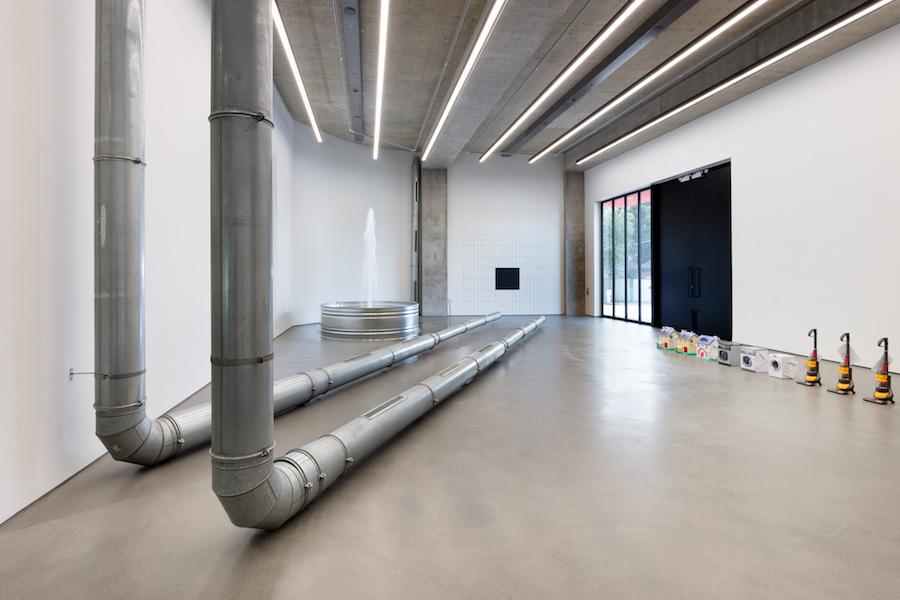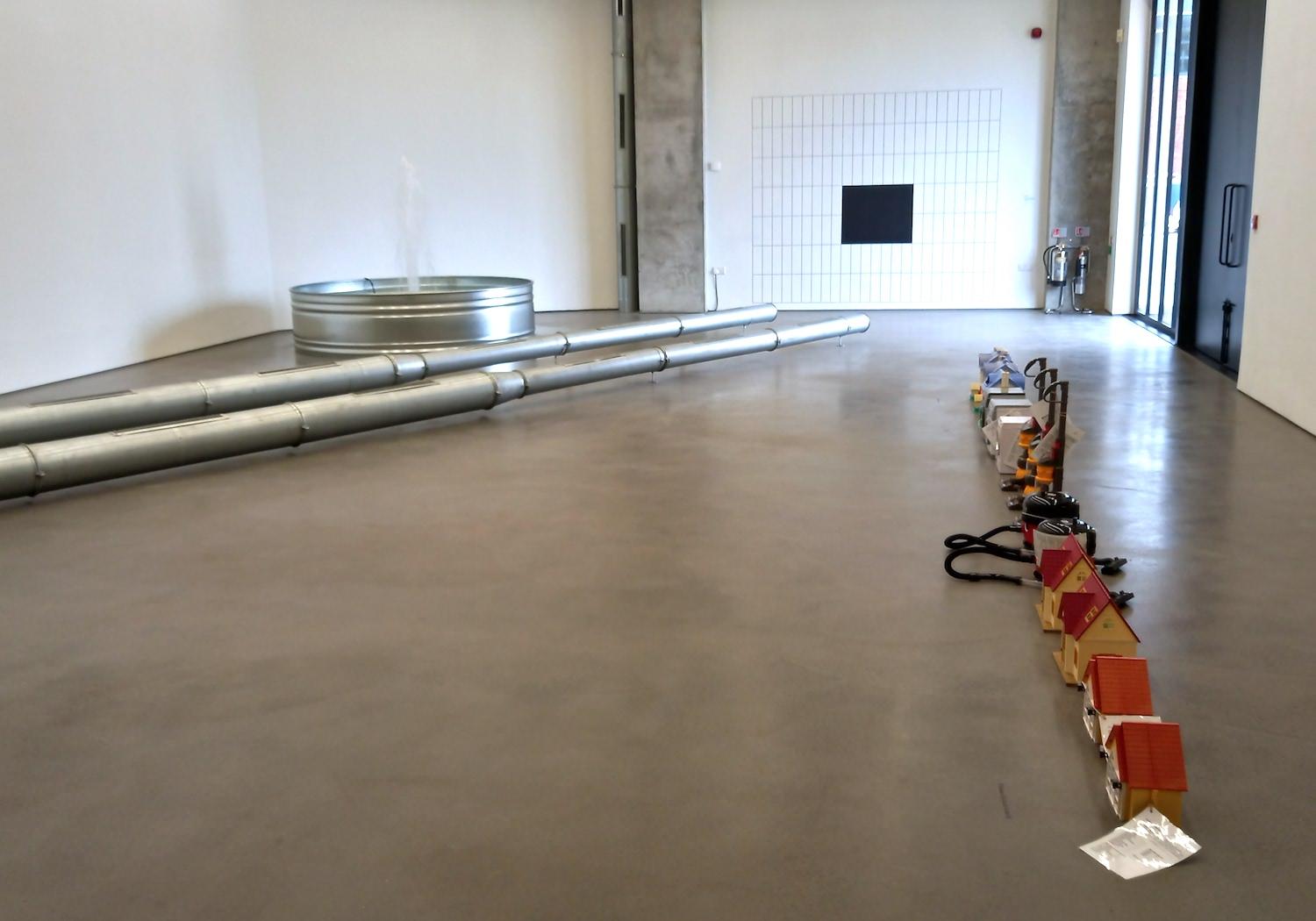Ghislaine Leung is one of the four artists nominated for this year’s Turner Prize, the winner of which will be announced on 5 December.
Her show in Eastbourne consists of ‘score-based’ works: they repurpose found objects, but Leung’s parameters for how to show them leave plenty of scope for the hosting Towner Gallery to influence the outcome. That relinquishing of control allow the socio-political and spatial conditions of art production, its presentation and re-presentation, to come to the fore. That may sound worthy but potentially dry – yet Leung goes about things with an appealing wit, and the results are compelling in themselves.
As explained in detail in your recent book ‘Bosses’, your starting point is how to make work rather than what work to make?
Yes, I aim to work with what I have, rather than what I don’t have – it’s untenable trying to work with what you don’t have, which is the position faced by many artists who can’t access the resources they need – which, of course, also exacerbates existing class, gender and racial hierarchies in our industry. I was interested in finding a mode of production that made space for a different kind of work. And this came from something I probably initially conceived of as a problem, I always thought you can make an artwork and you can perfect it in some way yourself. And then the work goes into a context that you can’t control and it has a different read or it changes or it shifts, and this was something I wanted to control. It was the wish to control that seemed like a clear problem to me. I wondered how to embrace the contingency of works instead, to embrace their vulnerability. Rather than thinking ‘how can I fix and control this? How can I maintain its integrity in the way that I have conceived it?’ I shifted to thinking that the resilience of the work could come from its vulnerability, its total contingency, its complete dependency, my trust in a situation.
Is that in line with Sol LeWitt’s approach as set out in ‘Sentences on Conceptual Art’, 1969, such as ‘Once the idea of the piece is established in the artist’s mind and the final form is decided, the process is carried out blindly’?
I’d see my work as more of a dialectical flip on LeWitt’s methodology. He starts with concepts which lead to the material form. For me, materials, inclusive of the sets of conditions and limitations I’m working with, are generative towards concepts. I don’t know the final form, and – given the highly contingent nature of the scores – I can’t and, in fact, don’t want to. This is why the works are scores rather than instructions, just as a musical performance isn’t quite the composer’s or the performer’s. In that sense, I am theoretically the composer, and the institution is the performer, and the work, in each iteration, comes from both. I like to be surprised by my work when I come into a show!

Ghislaine Leung: ‘Violets 2’, as installed at Simian, Copenhagen – GRAYSC Images, courtesy the artist & Simian
Can you say something about the largest work in your Turner Prize display?
The score for ‘Violets 2’ reads: ‘All parts of a ventilation system removed from Netwerk Aalst Bar during its 2017 refurbishment are reinstalled within the space of the exhibition and fixed on the floor. Using as much of the material as possible while keeping it all interconnecting. Spare pieces that do not fit this configuration are bracketed together in smaller formations. A welcome sign is installed.’
I was working there in Belgium from 2017-19, and we were thinking about who the institution was speaking to – about how often ‘the public’ is referred to like a separate and somewhat mysterious entity to be spoken to or placated. I was aiming to bridge this externality by thinking about the internality – the politics of the institution and my position in that – an immanent form of critique looking at the structures of power inside, rather than outside, the place. What about the people already in this room, the politics that are already here? So how the institution was organised in both social and physical structures. So many of the circuits of power, the things that allow for the functionality of the building, are rendered invisible. At the time, the institution was undergoing a renovation and discussing what was going to be removed and what was going to be inserted. The ventilation system that makes up ‘Violets 2’ was going to be removed as smoking was no longer allowed in the building, which made it surplus. And I was interested in what these forms of institutional waste were, who and what was considered valid or useful within these public-facing spaces. I took the ventilation system which had been on the ceiling of the bar, and mounted it on the floor of the gallery space above that bar, which had the same spatial footprint. And installed a welcome sign alongside it. I’m always interested in this institutional welcome, on who is being welcomed and why, especially in how ex-industrial spaces become art industrial spaces. Violets 2 has been on almost permanent tour since 2018, it flexes to fit into different spaces, and it shows something different about these spaces each time, as its parameters are shaped by these limits.

Ghislaine Leung: ‘Violets 2’, Towner Gallery, Eastbourne – Angus Mill Photography
You’re asking one institution to do something with another institution’s structures?
The way an institution performs a score says a lot about them, e.g. their Health and safety rules, what they want to achieve – that was my aim at that time, to acknowledge the systems of the institutions.
The sculpture we see reminded me somewhat of the 1960s ‘Square Tubes’ of Charlotte Poseneske – another artist who emphasised the cooperative aspects of her work.
Yes, and I think this is exactly what I mean about how materials can be generative. This becomes especially interesting in relation to historical artworks that refer or even enact forms of industrial production like Poseneske’s. What happens if you use existing industrial objects rather than fabricating them? What shifts what doesn’t? In a way, I’m trying to take something back into the use of art and to understand that as already an industrialised social structure, one that is often unacknowledged but shapes so much of what constitutes not only the art object but who can and can continue to, make art.
Why does the title refer to violets?
I had been thinking about how systemic prejudices are so often perpetuated by our own internalised ‘micro-violences’ that we do to each other and also ourselves. Ones that are fabricated into the internal structures of our institutions. And was struck by how close the pretty and flowery word ‘violets’ is to the loaded term ‘violence’.

Ghislaine Leung: ‘Hours’, 2022 – photo Paul Carey-Kent
‘Monitors’ broadcasts a baby monitor from one room to another, and ‘Hours’ divides the week between your studio hours, indicated by a Malevich-like black square, and the rest. I note you spend only 8% of your time in the studio – presumably, you’re constrained by factors such as being a mother?
Yes, being a mother, and working, and in multiple jobs. I think the earlier works like ‘Violets 2’ and ‘Public Sculpture’ were very much about institutional systems, and how they constitute the work, what their labour conditions are, how they work. In the past few years, especially since having a child, I’ve become more and more interested in how I work, how I have internalised various expectations and ideas about labour and value; questions that are about how I institute, and taking a position of critique into a more reflexive and lived form of actionism. As such the more recent scores have become less about the interrelation between two institutions, and more about my form of instituting, how my labour, life, limits, collide, are in conflict or grow… about that intra-institutional aspect of bringing myself in. For many years I felt I couldn’t do that, felt that how I lived didn’t have enough value to speak about, but more and more I feel that speaking about that situation is a necessity. And if you’re trying to make work inclusive, then life is really important within the work.

Ghislaine Leung: ‘Public Sculpture’, 2018 – Photo: Paul Carey-Kent
‘Public Sculpture’ presents a group of toys from the collection of the public library in Reading. They struck me as unusual toys?
They are fascinating, yes. Toy libraries often have a lot of these kind of role play toys, leading to questions about what roles we play, or the roles played in the construction of such roles. And there are two companies – Theo Klein in Germany and Casdon in the UK – who specialise in miniatures of branded goods, so you’ll get a Theo Klein Miele washing machine or a Casdon Henry Hoover etc.… I was interested in that double identity – in that one object has two brands attached. And the toys have another double identity: as individual objects they are toys in the library; as a set of objects, they are a loanable artwork by me. Both exist in the library system, and you have to join the library to access them, either way. So I’m interested in how the work circulates as well as how it is actioned through the score. And this doubling – or troubling – of identity is important to me, as a mother and an artist, as someone with a father from Hong Kong and a mother from London. I’m asking what identity is if you think of it as not so much as the objectifying question of ‘what you are’, but ‘how you are’.
Work by the four artists shortlisted for the Turner Prize 2023 (Jesse Darling, Ghislaine Leung, Rory Pilgrim and Barbara Walker) is on show at the Towner Gallery, Eastbourne to 14 April 2024. The winner will be announced on 5 December. Ghislaine Leung was nominated for her solo exhibition ‘Fountains’ at Simian, Copenhagen.
Top Photo: © Artlyst 2023

